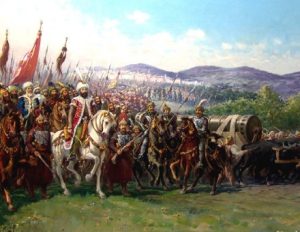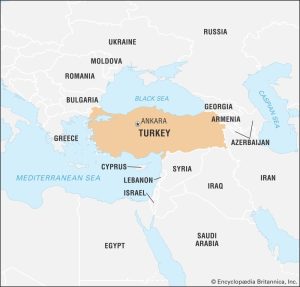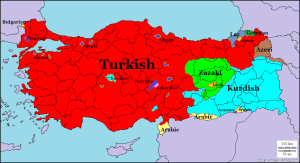History

The history of Turkey spans over thousands of years, with its origins dating back to the Neolithic period. The Anatolian peninsula, where modern-day Turkey is located, has been inhabited by various civilizations throughout history, including the Hittites, Phrygians, Lydians, Persians, Greeks, Romans, Byzantines, Seljuks, and Ottomans (Lewis, 2001).
The Seljuk Empire, which ruled over much of Anatolia from the 11th to the 13th centuries, paved the way for the rise of the Ottoman Empire in the late 13th century (Kreiser, 2008). The Ottoman Empire, which lasted for more than 600 years, became one of the most powerful empires in the world, with its territory spanning across Europe, Asia, and Africa. The empire was known for its military prowess, its administrative and legal systems, and its cultural and artistic achievements (McCarthy, 2019).
In the 19th century, the Ottoman Empire began to decline, and a series of reforms were introduced in an attempt to modernize the country and prevent its dissolution. However, the empire’s involvement in World War I proved to be a turning point, and it was eventually dissolved in 1922. Mustafa Kemal Atatürk, a military commander and statesman, established the Republic of Turkey in 1923, with himself as its first president (Balcı, 2020).
Under Atatürk’s leadership, Turkey underwent a series of political, economic, and social reforms, known as the “Kemalist revolution,” which aimed to modernize the country and transform it into a secular, democratic nation-state. The Kemalist reforms included the adoption of a new legal system based on the Swiss Civil Code, the introduction of a Latin-based alphabet to replace the Arabic script, and the promotion of women’s rights and education (Sönmez, 2019).
Since then, Turkey has undergone several political and social changes, including military coups, the rise of Islamic movements, and the accession negotiations with the European Union (EU). In recent years, Turkey has been facing various challenges, including political polarization, economic difficulties, and tensions with its neighbors (Sahin & Turan, 2020).
Location
Turkey is a transcontinental country located in the southeastern part of Europe and southwestern part of Asia. It is bordered by the Black Sea to the north, the Mediterranean Sea to the south, and the Aegean Sea to the west. To the east, it shares borders with Georgia, Armenia, Azerbaijan, Iran, and Iraq. The country has a total area of 783,356 square kilometers, with 97% of its territory located in Asia and the remaining 3% in Europe (Central Intelligence Agency, 2021).
The location of Turkey has been strategically important throughout history, as it sits at the crossroads of Europe, Asia, and the Middle East. The country has played a pivotal role in trade and cultural exchange for centuries, serving as a hub for the Silk Road and the Ottoman Empire.
The capital of Turkey is Ankara, which is located in the central part of the country. Istanbul, the largest city, is situated on the Bosphorus Strait, which separates Europe and Asia. Other major cities in Turkey include Izmir, Bursa, and Antalya, all of which are located along the Mediterranean coast (Central Intelligence Agency, 2021).
In conclusion, Turkey is located at the intersection of Europe and Asia, with a vast majority of its territory located in the Asian continent. Its strategic location has made it an important hub for trade and cultural exchange throughout history.

Climate
The climate in Turkey is predominantly Mediterranean, with dry and hot summers and mild and rainy winters. However, due to its diverse geography, the country has various climatic zones.
The coastal regions of Turkey experience a Mediterranean climate, characterized by hot summers and mild, rainy winters. The average temperature in the summer months of June to September ranges from 27°C to 30°C, while the winter temperatures average around 10°C. The coastal regions receive an average of 800 mm of precipitation per year.
In the north, the Black Sea region experiences a humid subtropical climate with mild, rainy winters and warm, humid summers. The region receives an average of 2,200 mm of precipitation per year. The temperature averages 25°C in the summer months and around 8°C in the winter.
In the interior parts of Turkey, the climate is dry and continental. The summers are hot and dry, with temperatures ranging from 30°C to 40°C. The winters are cold and snowy, with temperatures averaging around -5°C. The central region receives an average of 400 mm of precipitation per year.
The eastern part of Turkey experiences an alpine climate, with cold winters and cool summers. The temperature in the summer months averages around 15°C, while the winter temperatures can drop below -30°C. The region receives an average of 500 mm of precipitation per year.
The southeastern part of Turkey has a hot desert climate, with extremely hot summers and mild winters. The temperature in the summer months can reach up to 50°C, while the winter temperatures average around 10°C. The region receives an average of 300 mm of precipitation per year.
In conclusion, Turkey’s climate varies from Mediterranean to alpine and desert, depending on the location. The coastal regions experience hot summers and mild winters, while the interior parts of Turkey have dry and continental climates. The northern regions have a humid subtropical climate, and the eastern part of the country has an alpine climate. The southeastern part of Turkey has a hot desert climate.

Languages
Turkey is a culturally and linguistically diverse country that spans both Europe and Asia. The official language of Turkey is Turkish, which is spoken by the majority of the population. However, there are also several other minority languages spoken throughout the country. Turkish is a member of the Turkic language family, which includes languages such as Uzbek, Kazakh, and Azerbaijani. It is written in the Latin script, with some modifications to accommodate specific Turkish sounds. The language has undergone significant changes over the centuries, with influences from Arabic, Persian, and French. (Gulsoy, 2016)
There are also several minority languages spoken in Turkey, including Kurdish, Arabic, Laz, Circassian, and Armenian. Kurdish is the most widely spoken minority language, with approximately 20% of the population identifying as Kurdish. Arabic is spoken by a significant portion of the population, particularly in the southeastern regions of the country. (Yildiz, 2015)
Laz is a language spoken by the Laz people, who live primarily in the Black Sea region of Turkey. It is a member of the Kartvelian language family, which also includes Georgian and Mingrelian. The language is under threat of extinction, with fewer than 200,000 speakers remaining. (Gudava, 2018)
Circassian is another minority language spoken in Turkey, primarily by the Circassian people who live in the northeastern part of the country. It is a member of the Northwest Caucasian language family, which also includes Abkhaz and Kabardian. (Zelkina, 2014)
Finally, Armenian is also spoken in Turkey, primarily by the Armenian minority population. It is a member of the Indo-European language family, and is written in the Armenian alphabet. However, the use of the language has been greatly limited in Turkey, particularly following the Armenian Genocide in 1915. (Balakian, 2009)
In conclusion, the languages of Turkey reflect the country’s rich cultural and linguistic diversity. While Turkish is the dominant language, there are also several minority languages spoken throughout the country. These languages have their own unique histories and cultural significance, and play an important role in shaping the identity of Turkey and its people.





